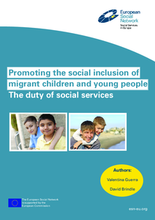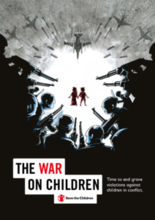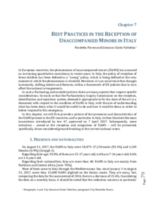Displaying 271 - 280 of 516
From ethnographic research with unaccompanied children in the United States and Guatemala, this paper explores emergent and, at times, conflicting narratives of care that young migrants encounter while in U.S. federal custody.
The main objective of this Joint Rapid Education and Child Protection Need Assessment (JRNA) was to identify education and child protection needs, priorities and capacities of Rohingya boys and girls in the camps, settlements and host community in Cox’s Bazar, Bangladesh to inform and provide the evidence-base for the 2018 Joint Response Plan (JRP).
As part of the "Children Come First: Intervention at the border" project, Save the Children Italy elaborates and disseminates, on a quarterly basis, a dossier containing quantitative and qualitative information (profiles) relating to migrant minors entering Italy. This dossier contains information relating to the last quarter of 2017.
Special guardians have been tasked with safeguarding the rights of unaccompanied minors in Croatia and providing general assistance within the system of care during their stay and/or during the status recognition procedure. The authors of this study discussed the experiences of practitioners in the field and some of the most important challenges they are facing within the special guardianship system.
Este recurso proporciona consejos para los cuidadores y otros para ayudar a abordar las necesidades de los niños inmigrantes y refugiados que han experimentado la separación traumática.
This report aims to address some common and key themes emerging from a questionnaire and in-person meeting to discuss the role of the social service workforce in the inclusion of migrant children and young people.
This paper presents a community based participatory research project, which adopted a photovoice approach with seven unaccompanied asylum-seeking children (UASC) living in foster care in the United Kingdom.
This report from Save the Children identifies concerning trends for the safety and wellbeing of children living in areas impacted by conflict, through analysis of the United Nations Annual Reports of the Secretary General on Children and Armed Conflict (CAAC) and new research by the Peace Research Institute Oslo (PRIO).
In this chapter from the The Twenty-third Italian Report on Migrations 2017, the authors provide a picture of the presences and characteristics of the unaccompanied minors present in the EU countries, and in particular in Italy, to then illustrate the main innovations introduced by law 47, approved on 7 April 2017.
This resource from the National Child Traumatic Stress Network provides key points related to traumatic separation and immigrant and refugee children, adapted from the NCTSN fact sheet Children with Traumatic Separation: Information for Professionals.









